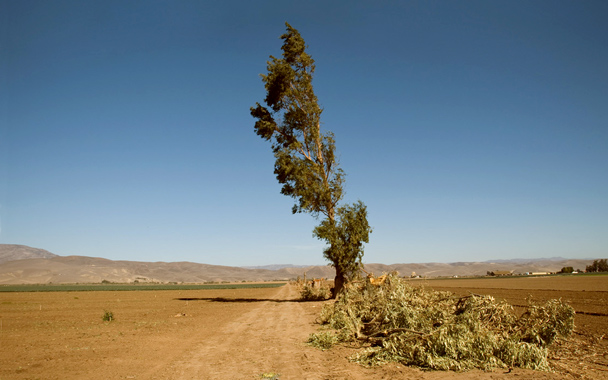On the morning of August 14, 2006, a truck set out from Paicines Ranch—a bucolic place in California’s San Benito Valley, all dun-colored pastures, twisting rivers, and green thickets—with a load of baby spinach. What no one knew was that the greens were contaminated with E. coli 0157:H7. An hour or so later, the truck backed up to a processing plant owned by Natural Selection Foods, known for its Earthbound Farm organic products. The spinach was washed, mixed with leaves from three other farms, and packed into six-ounce bags. Fewer than 48 hours after being picked, 15,660 pounds of spinach were distributed across the country. In the weeks that followed, the spinach left at least 205 consumers in 26 states and one Canadian province sickened. Of those, 103 had to go to the hospital, where 31 were treated for a condition that put them at risk for acute kidney failure. Twenty-eight recovered, but three were not so lucky. Two elderly women, one from Wisconsin and one from Nebraska, and a two-year-old boy from Idaho died.
Scientists were unsure—and still are to this day—how the spinach became contaminated. Despite this, however, the huge industry that is built on fresh-cut, bagged greens reacted with unprecedented speed. Within a month, 60 packers agreed to draw up a list of preventive measures. Five months later, the new coalition, which sells more than 99 percent of the Golden State’s leafy greens, formally released the California Leafy Green Products Handler Marketing Agreement, a 54-page set of rules. While some of the hastily implemented regulations were based on scientifically valid research, other standards were simply borrowed from those applied to other crops or arrived at through consensus. The agreement covers every aspect of farming. Many of its strictures are quite sensible (workers with diarrhea can’t handle fresh produce). Others introduce new layers of governmental oversight (four unannounced visits by inspectors each year). Sometimes the rules can seem contradictory. Cattle, known to be a primary source of E. coli, can graze within 30 feet of crops, but a compost pile containing cow manure must be 400 feet away. Often, guidelines are couched in vague language: Farmers should “consider” fencing and other measures that might reduce intrusions of wild animals that may carry pathogens. Seasonal lakes and ponds may attract wild animals and “should be considered as part of any land use evaluation.”
But good intentions have gone badly awry. In the name of food safety, farmers have reshaped the landscape in ways that, according to critics, have reversed two decades’ worth of environmental conservation. If the new policies are adopted by the federal government—and some say that it is only a matter of time—they will have profound ramifications for small, sustainable growers in postage-stamp fields thousands of miles from California. And there is scant evidence that the standards have actually addressed the real problem.
Until the outbreak, bagged greens were one of the marvels of industrialized agriculture, available in every grocery store from Anchorage to Miami, 365 days a year. A harried parent with a toddler in tow or a single person sitting down to a quick meal could grab a bag of salad fixings and dump them in a bowl. No need to cut or clean. Almost unknown 20 years ago, precut greens have tripled their market share in the past decade and now account for 67 percent of all sales of fresh-cut vegetables.
At least some of this phenomenal growth is due to Earthbound Farm. In 1996, the company, which operates in the heart of California, adopted a new technology—“breathable” plastic bags that permit greens to take in oxygen and exhale carbon dioxide without losing moisture, thus allowing them to remain “fresh” for 17 days. The original two-and-a-half-acre garden has grown to more than 40,000 acres, some owned by Earthbound, others by farmers who sell to the company. Earthbound’s rising-sun logo can now be found in 80 percent of the grocery stores in the United States and Canada, and its facility in San Juan Bautista can pack and ship 700,000 containers a day—more than 2.5 million pounds per week.
To step into an Earthbound Farm spinach field is to be overwhelmed by the incomprehensible vastness of it all. It looks identical to hundreds of operations that stretch across the valley floor, stopping only at the base of the faraway, hazy mountains. An area big enough to accommodate a dozen football fields is carpeted with symmetrical strips of tiny, perfect baby spinach plants with just enough space between the rows to allow for the passage of a mechanical harvester. A dozen Latino laborers wearing aprons, rubber gloves, and hairnets tend the mechanical beast as it creeps along. Two workers scramble in front of it, removing any damaged plants. Ahead of a ten-foot-wide band-saw blade, a series of wires called “ticklers” protrude down to rustle leaves and rouse any snoozing insects, which are whisked away by fans. The blade, inches off the ground, sends a green river of spinach up a conveyor belt and over an air gap that eliminates sticks, clumps of dirt, and heavy objects. The greens flow through a trough filled with chlorinated water and spew into white plastic containers. Moving as fast as they can, the field hands stack one crate after another on a trailer behind the harvester. In less than 90 minutes, the crew and the contraption pick 6,000 pounds of spinach, which is immediately loaded into a refrigerated truck beside the field.




 Pinterest
Pinterest






